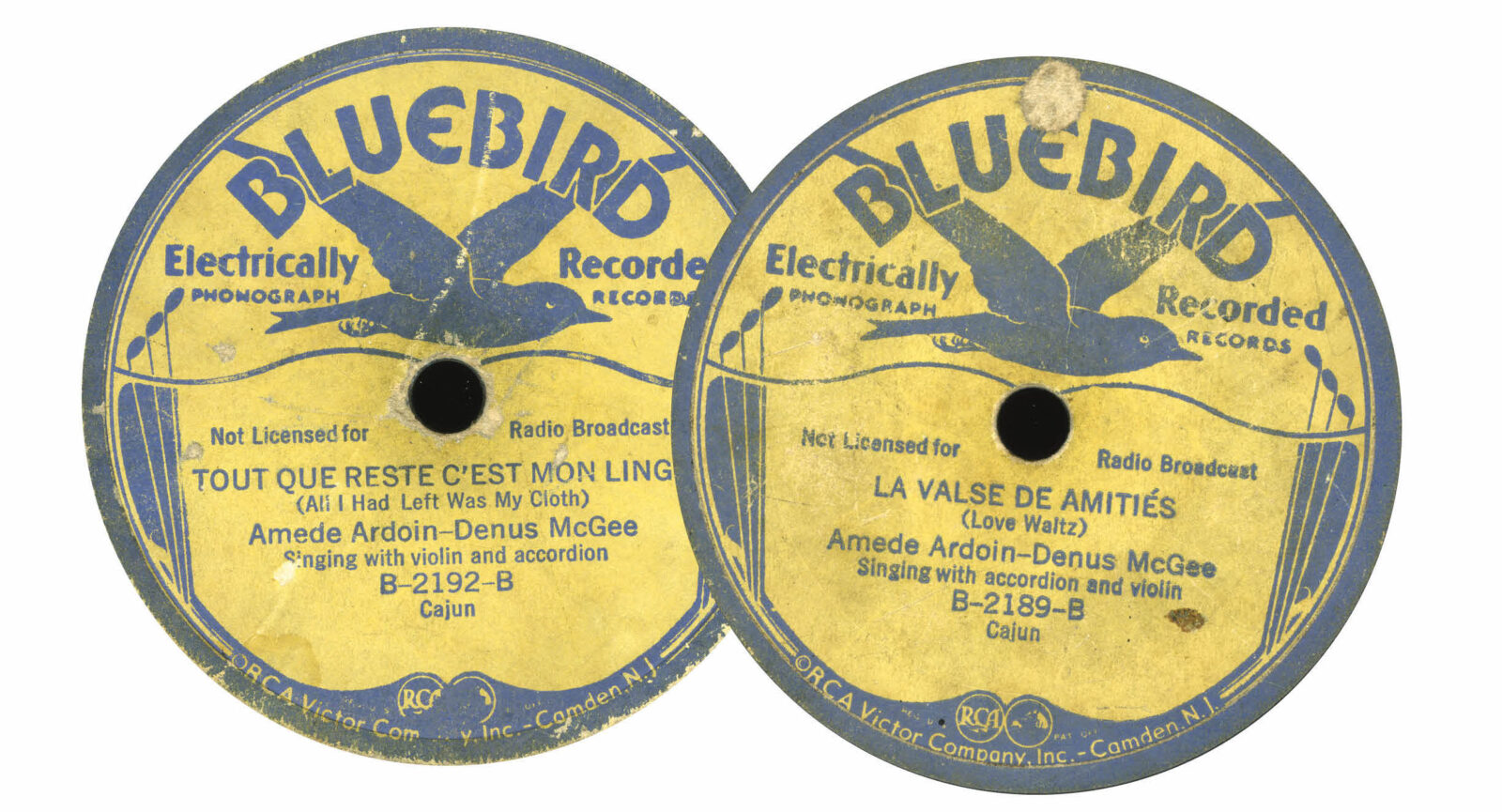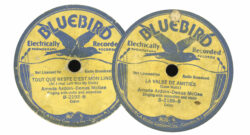Amédé Was the King
Creole musician Amédé Ardoin’s legacy
Published: May 31, 2022
Last Updated: June 1, 2023

Center for Louisiana Studies, University of Louisiana Lafayette
Ardoin’s musical reputation rests on a relatively small number of 78 rpm recordings.
“He played his music and he played it right. He had the people, man. Amédé was the king.”
—musician Anderson Moss
Like Buddy Bolden and Robert Johnson, his trailblazing contemporaries respectively in New Orleans jazz and Delta blues, Acadian Creole musician Amédé Ardoin shone brilliantly for a tragically short time. Ardoin’s commonalities with Bolden include confinement in a mental hospital and burial in an unmarked grave. With Johnson, he shares an enigmatic death and groundbreaking legacy captured in a few dozen 78 rpm recordings. Adding to the mystery of these three Black men’s lives, almost no images of them exist.November 3, 2022, is the eightieth anniversary of Ardoin’s death at the Central Louisiana State Hospital in Pineville. The musician who stood at the crossroads of Black Creole music and white Cajun music is buried amidst the hospital’s 2,500 unmarked graves of Black patients. The details of the assault that led to his death at the age of forty-four, and his unhinged final days, likely will never be verified.
Modern zydeco performer Sean Ardoin—a grandson of Amédé Ardoin’s musician cousin, Bois Sec Ardoin—hears magic in Amédé’s nearly hundred-year-old recordings. “You can feel the energy in the bouncing polyrhythms played on that diatonic accordion,” the three-time Grammy nominee said. “He played a D accordion, so he’s singing really, really high. And he’s playing really, really fast—an absolute virtuoso.”
Michael Doucet, the singing fiddler who leads the Grammy-winning Cajun band BeauSoleil, noted Ardoin’s impact as an innovator, composer, and poet. “Cajun music is known for its heart and soul and ability to move the listener,” Doucet said. “Amédé set the standard that remains today.”
Iry LeJeune, a white Cajun music star of the 1940s and ’50s, studied Ardoin’s recordings intently. “People who knew him say he would sit in his rocking chair listening to old records of Amédé Ardoin for hours on end,” Ann Savoy writes in Cajun Music: A Reflection of a People. It was Ardoin’s influence on LeJeune, the Cajuns’ most beloved musician, Savoy adds, that laid the groundwork for the decades of Cajun music that followed LeJeune’s death in 1955, at twenty-six years old.
“Iry LeJeune changed Amédé’s music a little bit,” Michael Doucet recently noted. “And then he [LeJeune] became the Cajun hero.”
Born on March 11, 1898, in L’Anse Rougeau, Evangeline Parish, Ardoin grew up on a farm near Basile. He spoke only Creole French. Learning to play the accordion in early childhood, he performed at house dances and dancehalls by his teens. Ardoin, Savoy writes, “was the musician to hire for country house parties, and he would bring huge crowds to the dancehalls in which he played.”
Fiddler Wade Frugé, one of Savoy’s interviewees, noted the influence white Cajun music had on the five-foot-tall Creole accordion prodigy whose singing was so plaintive and penetrating. “Amédé Ardoin learned his songs from the Cajuns, but he played them his style,” Frugé said. “The rhythm was different.”
Dennis McGee, the white Cajun fiddler born in 1893 in Bayou Marron, performed throughout southwest Louisiana with Ardoin in the 1920s. “People would go crazy when Amédé played,” McGee told Savoy. “He had a song where he’d really pull—it made me shake when he would start singing it.” Reflecting the peril a Black musician faced in the Jim Crow–era South, McGee recalled standing up to a white man who wanted to harm Ardoin. “I told him, ‘That’s a good man—leave him alone,’” McGee said. “We played a lot of music together and he was protected no matter where he went.”
Wade Frugé remembered that his uncle, Arteman “Bijoux” Frugé, was another of Ardoin’s protectors. Even so, Frugé says in the Alan Lomax documentary, Cajun Country: Don’t Drop the Potato, Ardoin often ran for his life. “When they start drinking that moonshine, you know, they didn’t want that Black man there.” In Creole fiddler Canray Fontenot’s account of the incident that led to Ardoin’s death, the itinerant musician was ambushed as he walked to his temporary residence at white farmer Celestin Marcantel’s place. Before the attack, Fontenot explained, Ardoin was sweating during a nearby dance after “playing a whole lot and singing a whole lot. So, one of Celestin’s daughters took a white handkerchief and she went and wiped his face. And they didn’t like that at all. They didn’t tell Amédé nothing right then. And somebody was waiting for him there, some of them white guys. They beat him up. He had to play dead. . . . He said many times [that his assailants said], ‘Well . . . there ain’t go’ be no white lady wiping his face no more.’”
After the assault, Ardoin descended into helplessness. “They had to go and feed him when it was time to eat,” Fontenot said. “Oh, he was plumb crazy.” Dennis McGee confirmed Ardoin’s detachment from reality, but also offered an alternative story about what caused Ardoin’s mental incapacity. In McGee’s telling, a Black fiddler poisoned Ardoin because he refused to perform with him. “Amédé told him, ‘If you and I play together, two Blacks, the whites are gonna kill us. I like to have Mr. McGee with me because Mr. McGee’s gonna help me. . . . You’re not gonna help me.’”
In 1998, concerts in New Orleans and Lafayette celebrated the hundredth anniversary of Ardoin’s birth. Other recognition included reissues of his recordings and a chapter in Michael Tisserand’s The Kingdom of Zydeco. In 2014, Darrell Bourque—a former Louisiana poet laureate and Louisiana Endowment for the Humanities’ 2019 Humanist of the Year—published If You Abandon Me, Comment Je Vas Faire: An Amédé Ardoin Songbook. The book’s sales raised funds for the Bringing Amédé Home project. In 2018, on Ardoin’s 120th birthday, hundreds of people attended the unveiling of a statue of the musician at the St. Landry Parish Visitor Center. Bourque saw the statue as a symbolic return to Acadiana for Ardoin, the seminal musician whose distant and anonymous burial place is sixty miles north in Rapides Parish. Bourque and another Acadiana educator, Patricia Cravens, spearheaded Bringing Amédé Home as well as the planting of lemon trees—a reference to the lemons Ardoin carried with him because lemon juice soothed his throat. Bourque saw Bringing Amédé Home as a social justice project: “It was my attempt to recognize the fusion of Creole and Cajun culture that we denied and tried to erase.”
John Wirt is the author of the New Orleans music biography Huey “Piano” Smith and the Rocking Pneumonia Blues. He’s also written thousands of music and film features and reviews for newspapers and magazines.
